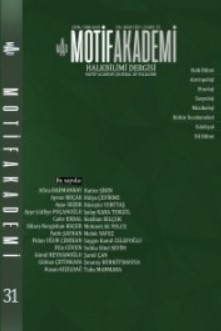DEDE KORKUT HİKÂYELERİNDE OTAĞIN TOPLUMSAL İNŞASI VE TOPLUMSAL CİNSİYET
SOCIAL CONSTRUCTION OF MARQUEE AND GENDER IN DEDE KORKUT STORIES
Author(s): Filiz GüvenSubject(s): Gender Studies, Cultural history, Customs / Folklore, Social history, Turkish Literature
Published by: Motif Halk Oyunları Eğitim ve Öğretim Vakfı
Keywords: Dede Korkut; gender of place; marquee; gender; cultural symbol;
Summary/Abstract: When the place is thought as publicly and privately, it becomes known with religion, culture, class, and gender by going beyond just being a home or a country. Therefore, although the adoption of a physical unit is intended to meet concrete needs at the beginning, the meanings it gains in the process is inherent to certain experiences. At this point, a fictional or physical place should be examined with the symbols that are loaded in time but actually constitute an important part of the social/ cultural structure. While cultural symbols form a power that shapes gender roles in the process of socialization, this formation turns into cultural codes of social memory through various cultural elements and by going through a certain phase. Thus, it is seen that places are matched with genders by acquiring figurativeness sometimes in accordance with the forms, sometimes how they are used, their usage practices or their positioning in social perception. In this sense, especially folk culture elements in which social acceptances are shaped can be seen as one of the important areas where the relationship between gender and place can be read in parallel with social acceptances. As a matter of social hierarchy, the direct or indirect relationships of the communities that belong to the same cultural structure create a gender distinction that can be encountered in almost every culture. This situation also carries an individual or a collective value. Within this scope, the relation of gender and place, whose primary field of occupation is culture in folk culture, can create a wide working area holding different perspectives. From this point of view, Dede Korkut stories which present many things about Turkish culture as a whole should also be examined within the relationship between gender and place.
Journal: Motif Akademi Halkbilimi Dergisi
- Issue Year: 13/2020
- Issue No: 31
- Page Range: 977-993
- Page Count: 17
- Language: Turkish

